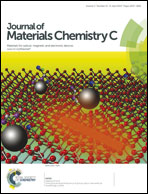Tuning the photoluminescence of porous silicon nanowires by morphology control†
Abstract
A systematic study was carried out to investigate the morphology and photoluminescence (PL) of porous silicon nanowire (Si NW) arrays fabricated by metal-assisted chemical etching with diverse etching conditions and starting Si wafers. The morphology of the Si NWs, including the orientation and porosity, could be well controlled. For Si NWs prepared from p-Si-(111) wafers, the orientation switched from the 〈100〉 to the 〈111〉 direction as the hydrogen peroxide (H2O2) concentration was increased. In addition, the NW porosity could be adjusted by changing the H2O2 concentration and the substrate doping elements. The PL intensity of the NWs correlated directly with their porosity. The PL intensity was strongly dependent on the oxidizer concentration, substrate orientation, and doping element of the starting Si wafer. The maximum PL enhancement ratio reached 14.5 when the concentration of H2O2 was doubled. The photoluminescence of p-Si-(100) was 1.15, 1.39 and 1.45 times stronger than that of p-Si-(111) with 0.25, 0.5, and 0.75 M H2O2, respectively. The morphology-controllable fabrication and tunable optical properties of such porous Si NWs will promote research on the application of semiconductor optical nanodevices.


 Please wait while we load your content...
Please wait while we load your content...